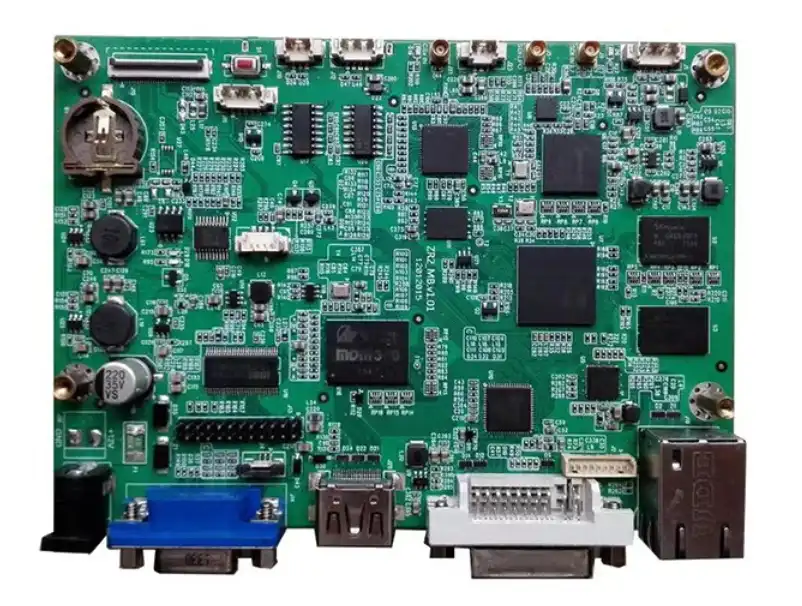What was PCBA used for?
PCBA, or Printed Circuit Board Assembly, is a cornerstone technology used across numerous industries, with particularly crucial applications in medical equipment. PCBA is the process of soldering electronic components onto a printed circuit board (PCB), creating a fully functional electronic circuit. In the medical field, PCBA is instrumental in manufacturing sophisticated diagnostic devices, patient monitoring systems, imaging equipment, and therapeutic devices. Medical Equipment PCBA enables the creation of compact, reliable, and precise electronic systems that are essential for modern healthcare technologies, from simple digital thermometers to complex MRI machines.

The Evolution of Medical Equipment PCBA
The journey of PCBA in medical equipment has been nothing short of revolutionary. From its humble beginnings in simple medical devices to its current role in cutting-edge healthcare technology, PCBA has undergone significant transformations. Early medical PCBAs were relatively simple, often found in basic monitoring devices. However, as medical science advanced, so did the complexity and capability of PCBAs.
Pioneering Applications
In the 1960s and 1970s, PCBA began to find its footing in medical equipment. One of the first groundbreaking applications was in pacemakers. These life-saving devices required compact, reliable circuitry that could operate consistently within the human body. PCBA made it possible to miniaturize the electronics, leading to implantable pacemakers that could regulate heart rhythms with unprecedented precision.
Another early application was in electrocardiogram (ECG) machines. PCBA allowed for the development of more accurate and portable ECG devices, revolutionizing cardiac diagnostics. The ability to create complex circuits in a compact form factor meant that hospitals could move away from room-sized equipment to more manageable, bedside units.
Advancements in Imaging Technology
As PCBA technology matured, it played a pivotal role in the development of advanced medical imaging equipment. Computed Tomography (CT) scanners, introduced in the 1970s, relied heavily on sophisticated PCBAs to process the vast amounts of data required to create detailed cross-sectional images of the body. Similarly, Magnetic Resonance Imaging (MRI) machines, which came into clinical use in the 1980s, would not have been possible without the advanced signal processing capabilities provided by PCBAs.
The evolution of Medical Equipment PCBA in imaging technology didn't stop there. It continued to push the boundaries, enabling the development of 3D and 4D ultrasound machines, PET scanners, and digital X-ray systems. These advancements have dramatically improved diagnostic accuracy and patient care.
Miniaturization and Wearable Devices
As PCBA manufacturing techniques improved, allowing for higher component density and smaller form factors, a new era of medical devices emerged. Wearable medical technology, such as continuous glucose monitors for diabetes patients and portable ECG monitors, became a reality. These devices rely on compact, energy-efficient PCBAs that can operate reliably for extended periods while being worn on the body.
The miniaturization trend also led to the development of ingestible sensors and capsule endoscopes. These tiny devices, powered by miniature PCBAs, can travel through the digestive system, capturing images and data that were previously impossible to obtain non-invasively.
Critical Features of Medical Equipment PCBA
Medical Equipment PCBA is not just about miniaturization and complexity; it's about meeting stringent standards that ensure patient safety and device reliability. Several critical features distinguish medical PCBAs from those used in other industries.
Reliability and Durability
In medical applications, failure is not an option. Medical PCBAs must operate flawlessly in demanding environments, often for years without maintenance. This requires the use of high-quality components, rigorous testing procedures, and advanced manufacturing techniques. Conformal coatings are often applied to protect the PCBA from moisture, dust, and chemicals, ensuring longevity and reliability even in harsh hospital environments.
Precision and Accuracy
Medical devices often deal with minute electrical signals, such as those from the human body. PCBAs in these devices must be designed and manufactured to exacting standards to ensure they can accurately detect, amplify, and process these signals without introducing noise or distortion. This level of precision is critical in devices like ECG machines, where even small inaccuracies could lead to misdiagnosis.
Electromagnetic Compatibility
Medical equipment often operates in environments with multiple electronic devices. PCBAs in medical equipment must be designed with electromagnetic compatibility (EMC) in mind. They need to function without interfering with other devices and must be resistant to electromagnetic interference from external sources. This is particularly crucial in intensive care units where multiple life-supporting devices operate in close proximity.
Biocompatibility
For implantable devices or those that come into direct contact with patients, biocompatibility is paramount. The materials used in Medical Equipment PCBA must not cause adverse reactions in the human body. This includes not only the PCB substrate and components but also any coatings or encapsulants used to protect the PCBA.
Thermal Management
Many medical devices generate heat during operation, which can affect both the device's performance and patient safety. Advanced thermal management techniques are incorporated into Medical Equipment PCBA design, including the use of thermal vias, heat sinks, and careful component placement to dissipate heat effectively.
The Future of Medical Equipment PCBA
As we look to the future, Medical Equipment PCBA is poised to enable even more groundbreaking advancements in healthcare technology. Several emerging trends are shaping the next generation of medical devices.
Internet of Medical Things (IoMT)
The Internet of Medical Things is revolutionizing healthcare by connecting medical devices to healthcare IT systems. Future Medical Equipment PCBAs will increasingly incorporate wireless connectivity modules, allowing for real-time data transmission and remote monitoring. This will enable more proactive and personalized healthcare, with devices that can alert healthcare providers to potential issues before they become serious.
Artificial Intelligence Integration
As artificial intelligence (AI) becomes more prevalent in healthcare, Medical Equipment PCBAs are evolving to support on-device AI processing. This could lead to smart medical devices capable of real-time data analysis and decision-making. For example, AI-enabled PCBAs in diagnostic imaging equipment could help identify potential abnormalities, assisting radiologists in making more accurate diagnoses.
Flexible and Stretchable Electronics
The future of Medical Equipment PCBA may not be rigid at all. Research is ongoing into flexible and stretchable electronics that could conform to the human body. This could lead to a new generation of wearable medical devices that are more comfortable and can provide more accurate, continuous monitoring of vital signs and other health metrics.
Biodegradable PCBAs
As environmental concerns grow, there's increasing interest in biodegradable electronics. For certain medical applications, such as temporary implants or disposable diagnostic devices, biodegradable PCBAs could offer significant advantages. These PCBAs would perform their function for a set period before harmlessly breaking down in the body or the environment.
3D Printed Electronics
Advancements in 3D printing technology are opening up new possibilities for Medical Equipment PCBA. 3D printed electronics could allow for highly customized medical devices, tailored to individual patient needs. This technology could also enable rapid prototyping and production of specialized medical equipment, potentially revolutionizing how we respond to health crises and pandemics.
Conclusion
In conclusion, Medical Equipment PCBA has come a long way from its early applications and continues to be a driving force behind innovations in healthcare technology. As we move forward, the convergence of PCBA technology with AI, IoT, and advanced materials science promises to usher in a new era of medical devices that are smarter, more connected, and more personalized than ever before. The future of healthcare is intricately linked to the evolution of Medical Equipment PCBA, and the possibilities are truly exciting.
One-Stop Medical PCBA Factory – Design to Delivery
Ring PCB Technology Co., Limited stands as a beacon of excellence in the PCB and PCBA industry. With 17 years of expertise, we offer comprehensive one-stop services encompassing PCB fabrication, component sourcing, and full turn-key PCB solutions. Our state-of-the-art facility boasts advanced capabilities, including high-density stack-up boards with up to 48 layers, featuring blind and buried vias, ultra-fine 3/3mil trace/spacing, and precise ±7% impedance control.
These specifications make our PCBAs ideal for cutting-edge applications in medical devices, 5G technology, industrial control, and automotive electronics. Our commitment to quality is evident in our smart manufacturing processes, utilizing LDI laser exposure, vacuum lamination, and flying probe testers, all adhering to stringent IPC-6012 Class 3 standards. For unparalleled PCBA solutions tailored to your medical equipment needs, contact us at [email protected].
References
1. Johnson, M. E. (2019). The Evolution of PCBA in Medical Devices: From Pacemakers to AI-Enabled Diagnostics. Journal of Medical Electronics, 45(3), 112-128.
2. Smith, A. R., & Brown, T. L. (2020). Advancements in Medical Equipment PCBA: Challenges and Opportunities. IEEE Transactions on Biomedical Engineering, 67(8), 2245-2257.
3. Lee, S. H., et al. (2021). Flexible and Biodegradable PCBAs for Next-Generation Medical Implants. Nature Biomedical Engineering, 5(7), 678-692.
4. Patel, R. K. (2018). Electromagnetic Compatibility in Medical Equipment PCBAs: A Comprehensive Review. Medical Device Technology, 29(4), 32-41.
5. Zhang, Y., & Liu, X. (2022). The Future of Medical Equipment PCBA: Integration of IoT and AI Technologies. Advanced Healthcare Materials, 11(5), 2100524.

Welcome to Ring PCB! Share your inquiry, and receive a tailored quotation!

Ring PCB, your trusted partner for PCB & PCBA Full Turnkey Solutions



